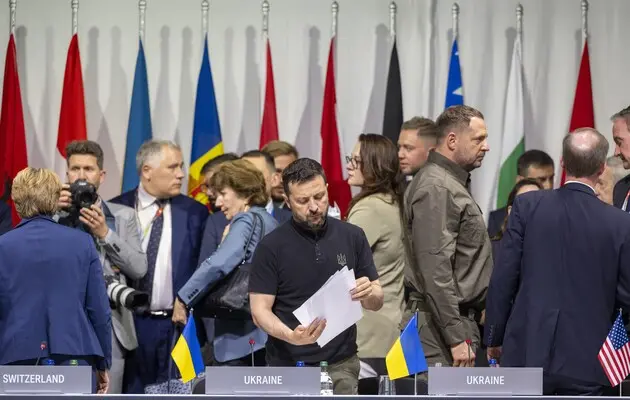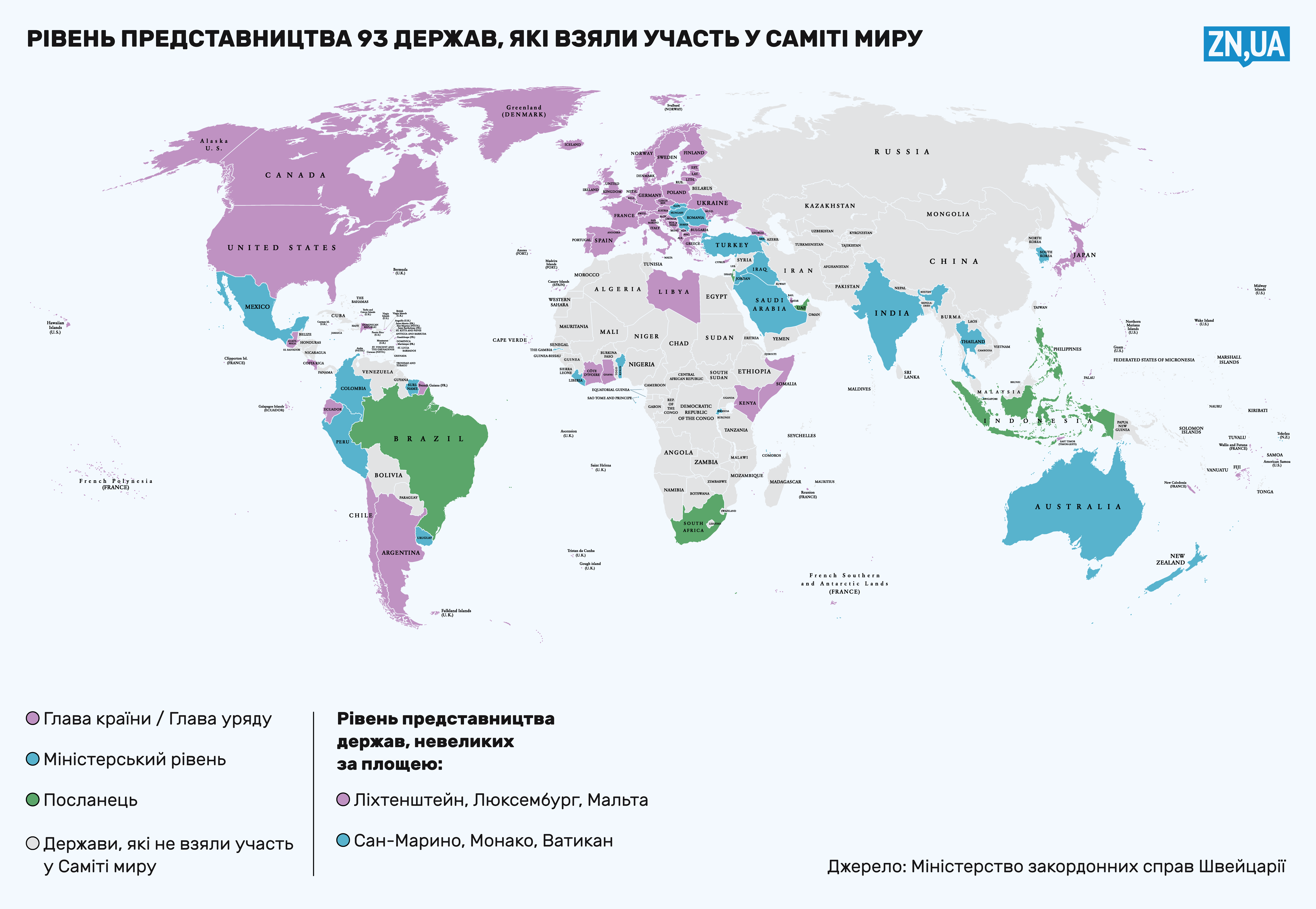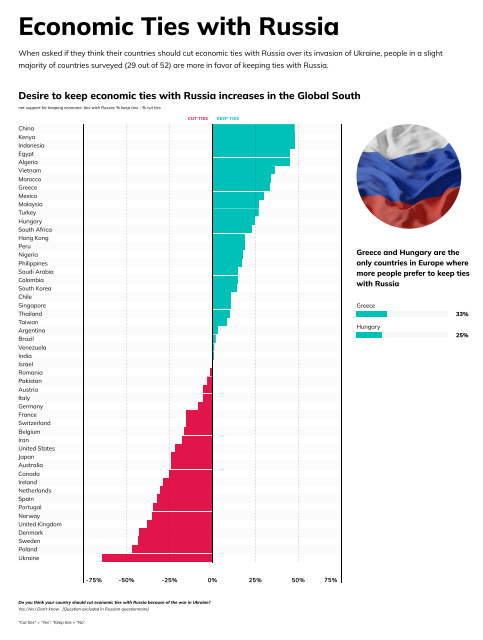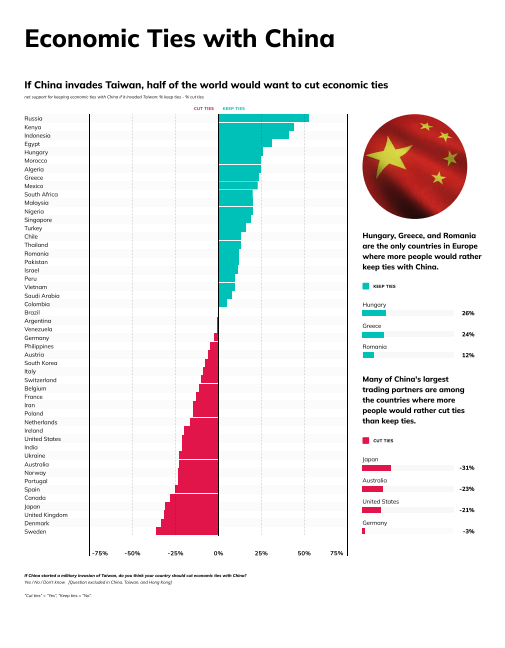Peace Summit in Switzerland: The First Rehearsal. Does Ukraine Have Time for Follow-up?

So, the Peace Summit, the necessity of which official Kyiv has been talking about all along, has come to fruition.
In fact, this is the main success of this forum, which was recognized by many of its participants, who called the event in Bürgenstock, Switzerland, “the first step towards the peace process.” German Chancellor Olaf Scholz defined the summit with uncharacteristic figurativeness as “a diplomatic sapling that we are now watering to make it grow bigger.”
These modest and cautious formulations stand in stark contrast to the fanfare of the “One Telethon,” overblown by Ukraine’s Presidential Office, which inflated the expectations from the first, inaugural, Peace Summit to the limit. This led to vastly exaggerated expectations and then to a noticeable disappointment of many Ukrainians.
Yes, the final communiqué of the summit mentions the Ukrainian Peace Formula and begins with the words “War of the Russian Federation against Ukraine” (which could have been otherwise). Yes, the document states that the basis for “achieving a comprehensive, just and sustainable peace in Ukraine” will be the Charter of the United Nations, “including the principles of respect for the territorial integrity and sovereignty of all States.” Yes, we should pay tribute to the Ukrainian diplomatic team, which managed to get its way and secure these formulations (although, as it turned out later, at the cost of reducing the number of signatories).
But by and large, the communiqué is a document “for all the good things against everything bad.” It lacks the main thing: mechanisms to cause the aggressor state, Russia, to stop its war against Ukraine.
Moreover, of the 10 points of President Zelenskyy’s Peace Formula, about which even a whole movie was shown at the telethon on the eve of the summit, only three were brought to the event as a result of complex multilateral compromises, and they are not at all about the territorial integrity of Ukraine or the withdrawal of Russian troops from its territory. Yes, nuclear and food security are very important, and so is the return of every single Ukrainian prisoner and our children deported by the aggressor. However, discussing these items even at the highest level in the most representative forum will not end the war or restore peace in Ukraine.
However, as one of our wise interlocutors philosophically noted, your perception of the results of the summit depends on your expectations. If you hoped that the world leaders, gathered in Switzerland in large numbers, would jointly write a clear and in all respects satisfactory to Ukraine plan to end Russia's war against our country, which would bring us a speedy peace, you will be deeply and bitterly disappointed. The summit did not bring that to Ukraine. Nor did it produce a plan to end the war. In the end, its goals were much more modest: “to initiate a peace process and develop steps towards it.” The development of more ambitious solutions was postponed until the next Peace Summit. As for when and where it will take place, the meeting in Bürgenstock left that matter undecided...
If, when counting the number of participants in the summit, you noticed that the 92 countries that sent their representatives to Bürgenstock are less than half of the UN members, of which there are 193 today, and noticeably less than the 160 invited, and only 78 signatories to the final communiqué (plus four international organizations), you are sure to be saddened. The map prepared by ZN.UA, which hurts the eyes and hearts by the abundance of gray color marking the countries that did not come to the summit, will nothing but deepen your sadness.
The initial hopes of the Office of the President of Ukraine, which deliberately chose the dates of the summit to coincide with the G7 summit and expected that the seven powerful people and President Zelenskyy, who joined them, would persuade and bring all the guests — leaders of influential countries of the Global South (including Indian Prime Minister Narendra Modi and even, why not, the head of China, Xi Jinping, if he suddenly came to the G7) — from Italy straight to Switzerland, were not justified in many respects. Xi did not come at all — neither to Italy, nor to Switzerland. Modi returned home to attend to domestic affairs after the recent elections. And the leaders of other states of the Global South who attended the summit in Italy preferred to send lower-level representatives to Bürgenstock. Both UN Secretary General António Guterres and IAEA Director General Rafael Grossi ignored the Peace Summit, although the latter was supposed to defend “the validity of the purposes and principles of the UN Charter, international law” and discuss nuclear security issues.
But if you focus on the fact that the summit in Switzerland was attended by representatives of all continents, leaders of all G7 states, representatives of almost all G20 states (except China and Russia), and even BRICS (!) states (again without China and Russia) — despite the enormous pressure from Beijing and Moscow — as well as envoys of eight international organizations, the summit may seem quite solid and representative.
However, when counting the number of participants and studying the level of representation, few people pay attention to the fact that at some stage of preparation the Global Peace Summit (as it is still called in Ukraine) officially turned into the Summit on Peace in Ukraine. Can you feel the difference?
Several ZN.UA interlocutors, who are experienced in geopolitics, are disappointed that the summit turned out to be “only for Ukraine” and not “a summit for everyone.” What is meant by that? It means that President Zelenskyy’s 10-point Peace Formula should have been presented as the basis and possibility of creating a future global international security structure since the old one (which is obvious to everyone) is no longer working. In the opinion of seasoned diplomats and politicians with whom ZN.UA spoke, when addressing other states and emphasizing the brain death of the UN and the OSCE, the old rules of coexistence on this planet, it was necessary to offer the Ukrainian Formula as the basis of new rules, which, of course, have yet to be developed in detail by the whole world. This approach, according to our interlocutors, rather than focusing only on the problems of war-afflicted Ukraine (which a large part of the world does not care about), could have interested a wider circle of other states since they would have been given the opportunity to join in the creation of something globally important that would benefit them specifically. And only after the groups of countries ready to make efforts in a certain direction have developed concrete and detailed proposals on all 10 points of the Ukrainian peace plan should the Peace Summit have been convened. Is it ambitious? Pretty much so. But in our leaders ambition comes in abundance.
After all, from the very beginning, Kyiv intended and, judging by the statements in Bürgenstock, still intends to demonstrate to Russia that the “world majority” is on Ukraine’s side and that this majority will support President Zelenskyy’s 10-point Peace. And then, having worked out the peace plan in detail, it will put it on Putin’s desk for implementation. No one has yet explained why Putin would commend the plan and, most importantly, how he will be forced to do so.
If the Office of the President of Ukraine hoped to gather a “world majority,” then, as many experts believe, the Peace Summit should have been held either at the end of 2022 or at the very beginning of 2023 — immediately after the announcement of President Zelenskyy’s Peace Formula and Ukraine's then significant successes at the frontline, when the world had not yet had time to recover from the shock and fatigue of the war, when support for Ukraine was off the scale. On the eve of the anniversary of Russia's full-blown invasion of Ukraine in February 2023, it was the world majority — 141 (!) states — that supported the UN General Assembly resolution on achieving a comprehensive just and sustainable peace in Ukraine. Which, by the way, unlike the communiqué of the Swiss summit, called for the immediate withdrawal of Russian troops from Ukraine. That is when we should have forged the ironclad international support while it was hot. Alas, might-have-beens are the bane of history, so let us delve into the results of the recent summit by analyzing the motives and goals of its initiators, the main participants and those who ignored it.
For President Zelenskyy, the Peace Summit is a personal story, in which he has invested himself to the fullest — both emotionally and physically — by traveling to many countries and calling many leaders, personally persuading them to participate in the event. The Ukrainian diplomatic corps was tasked by the Presidential Office to ensure the maximum presence of foreign participants at the summit at the highest possible level, to which the main efforts of Ukrainian embassies and the central apparatus of the Ministry of Foreign Affairs have been devoted over the past six months, under the close and unswerving supervision of the head of the Presidential Office, Andrii Yermak.
Personal communication and mass events/shows are the Ukrainian president's second nature and favorite thing, where he can turn on the charm and use his acting skills, which has served Ukraine well on the international arena since the war began. This time too, the Ukrainian president’s diplomatic activity and media openness have contributed to a new wave of interest in Ukraine and the Russian-Ukrainian war, which had noticeably declined in recent months.
But Zelenskyy had personal motives for such frenzied activity. The large number of world leaders from all corners of the planet who came to the summit initiated by Ukraine should nullify the statement, persistently propagated by Russia and personally by Putin, about the illegitimacy of the Ukrainian president after the expiration of his five-year term of office. The peace summit has essentially become an international legitimization of President Zelenskyy.
The president’s entourage also had another reason to maximize the presence of participants at the Peace Summit. According to ZN.UA, communication between Kyiv and Moscow has long been quite active through various communication channels, and not only the issues of prisoner exchange, return of hostages and Ukrainian children are being discussed. The conditions for ending the war are also discussed during these contacts on neutral territory — mostly in the eastern hemisphere. And Russians, until Putin’s Friday speech at the Foreign Ministry, saw the resumption of the talks from no other point than where they broke down in Istanbul in the spring of 2022. Putin went further in his speech to diplomats, claiming already five regions of Ukraine. According to our sources, Ukraine’s Presidential Office assumed that a successful Peace Summit would strengthen Kyiv’s position in these so far unofficial and unpublicized quasi-negotiations with Moscow.
For Switzerland, which kindly agreed to host the Peace Summit, this forum is an opportunity to add to its image as a solid “money box” the touches of a noble “peacemaker.”
But unlike Kyiv, which had pinned excessive hopes on the Swiss summit, Bern is quite modest. Its hostess, President Viola Amherd, frankly admitted: “We will not be able to proclaim peace for Ukraine,” “our goal is to inspire the process of seeking peace in Ukraine.”
Nevertheless, on the eve of the summit, Swiss journalists dreamily speculated about the possibility of launching a historic “Bürgenstock process” similar to the Helsinki process.
It is too early to judge whether the Bürgenstock summit will go down in history, or whether future textbooks will not even remember it. But Switzerland and its president already have problems. And it is not only the complication of relations with Russia and Russian cyberattacks on the Swiss government. Local right-wingers are already criticizing Viola Amherd for her “excessive fascination” with Volodymyr Zelenskyy, which, in their opinion, has resulted in a violation of Switzerland’s neutrality by holding the summit on Ukraine’s initiative and without inviting Russia. The same opinion is held by some states, mainly from the Global South, which have already given up hopes for the neutrality of this country.
And what about the West?
According to our knowledgeable interlocutors, the United States does not believe in Zelenskyy’s Peace Formula. Although at first (a year ago) the White House publicly stated that any peace talks concerning the situation in Ukraine should start with a discussion of the 10-point plan presented by the Ukrainian president, Washington then essentially left the topic aside, making it clear to Kyiv — “do whatever you want, but only without us.”
Joe Biden is the only G7 leader who sent a second person to the summit instead of himself. Kamala Harris, albeit a vice president, unlike her boss when he was vice president, has never been involved in Ukraine issues at all. The pre-election events in California, where Biden flew off to, are invoked as a general explanation of his neglect for the Peace Summit. In fact, the White House saw no apparent success to be gained from Biden’s participation in the Ukraine Peace Summit. If it were electorally advantageous, would the American president have missed the opportunity? Instead, he imagined Donald Trump at the inexorably approaching TV debates: “Well, Joe, were you at the peace summit? So where is peace in Ukraine?”...
Of course, Washington sweetened the bitter pill of the absence of the leader of the free world at the Bürgenstock summit with two meetings between Biden and Zelenskyy during the week (during the celebration of the 80th anniversary of the Allied landings in Normandy and at the G7 meeting in Italy), the signing of a security agreement between Ukraine and the United States on the margins of the G7 summit, and the allocation of $1.5 billion for Ukraine’s energy sector announced by Kamala Harris at the summit in Switzerland. And, of course, the G7 decision on frozen Russian assets and $50 billion for Ukraine from the proceeds from them, which was pushed through by the US.
But if the United States has its own vision of ending the Russian-Ukrainian war (which, however, is highly doubtful), it is certainly not based on peace summits, no matter how many of them there may be in the future.
The United States has its own game with Russia and China. And the latest American move in it is a significant strengthening of sanctions against the Kremlin, along with the introduction of new, tougher, secondary sanctions against third-country entities (including China) involved in circumventing Western restrictive measures against Russia and fueling the Russian military machine. This is a far more effective strike against the aggressor than the Peace Summit communiqué, even if it mentions the Ukrainian Peace Formula. “Strangulation as the main method of economic warfare against Russia,” this is how The Bell succinctly described the new U.S. sanctions.
The rest of the West, fully represented at the summit, and overwhelmingly at the highest level, once again reaffirmed its support for Ukraine and its Peace Plan. But this has already been done many times before. A year ago, the Peace Formula was supported by the European Union, the G7, the PACE and all countries individually.
The summit should not have been held for the sake of the West, and it is clear that it was all planned for the sake of the Global South. Since last year, Western diplomats and some Western leaders who joined them shortly before the summit have been personally helping Ukraine to convince as many “non-aligned” countries as possible to participate in the peace forum initiated by Ukraine. But, alas, they were not very successful. Therefore, in response to a comment by a United Nations official to Reuters that “the summit risks showing the limits of Ukrainian diplomacy,” for the sake of fairness, we would like to note that the Bürgenstock summit showed, first and foremost, the limited diplomatic influence of the West.
For the Global South, the summit, unfortunately, was not a notable and important event. Nevertheless, according to former Ukrainian Foreign Minister Pavlo Klimkin, the main positive of the Peace Summit is the creation of a platform “for communication between the West and non-West, and the preservation of the opportunity for this communication, which is increasingly difficult to achieve.”
The apparent split between the West and the South in assessments of Russia’s war against Ukraine became even wider and deeper after last October 7, when Hamas terrorists attacked Israeli settlements, and subsequent events around Gaza. The next round of conflict in the Middle East not only drew much of the world's attention away from Ukraine, but also caused a tremendous wave of irritation in the largely pro-Palestinian South with the West siding with Israel.
The shadow of this irritation fell on Ukraine as well, as the South saw a “double standard” in the Western assistance to our country and that the suffering of the Palestinians in Gaza has fallen on deaf ears in Western capitals.
Even before that, Ukraine was and remains for the majority of Southern states — Asia, Africa, Latin America — a distant, little-known country, whose problems and troubles they do not care about. (Why this is so is a separate big topic.) A significant, if not overwhelming, part of the Global South is an unplowed diplomatic field for Ukraine....
Therefore, the participation of representatives of at least some countries of the Global South in the Peace Summit can already be considered a certain success. The most vivid success story is Argentina. After winning the elections, its new president, Javier Milei, went further than refusing to join BRICS (although an application had already been submitted). After communicating with the Ukrainian president, who came to his inauguration, and then Zelenskyy’s personal letter with a request to attend the Peace Summit, the Argentine "terminator" put aside his urgent domestic political affairs and came to Bürgenstock. Shortly before that, Argentina offered Ukraine some of its assault troopers and joined the Ramstein format.
Unexpectedly, Saudi Arabia, which until recently maintained suspense about its participation in the Peace Summit, pleased us with its presence. After the rapid visit of President Zelenskyy to the Kingdom just three days prior to the summit and his communication with High Crown Prince Muhammad bin Salman Al Saud, the forum in Bürgentstock was honored by Foreign Minister Faisal Bin Farhan Al Saud, who stayed there longer than planned. That said, Saudi Arabia did not sign the summit communiqué (experts explain this by the Saudis’ desire to remain “neutral” in order to become a link between the West and the non-West, and possibly a platform for future negotiations between Kyiv and Moscow, or at least a second Peace Summit with Russia’s participation).
There are not many states in the world today that can influence Russia. Therefore, involving Saudi Arabia in the work on the plan to end the war is very important for Kyiv. As Pavlo Klimkin notes, “the Chinese are behind it and it can influence oil prices”: “If the Saudis step up production, they can simply bring oil prices down, and this is actually not a bad lever (of influence – T.S.) on Russia as well.
But the failures on the “southern front” in preparing and holding the summit far outweighed the successes.
And the demarche of Colombian President Gustavo Petro, who refused to come to the summit at the last minute, after he had already been officially registered among the participants, is an unfortunate but not the biggest of these setbacks.
One could have been happy about the presence in Bürgenstock of the foreign minister of India, a BRICS member, who came despite enormous pressure from Moscow. But India did not sign the final document. And although it is only a political declaration, not a legally binding document, New sDelhi did not want to sign it, explaining this by Russia’s absence from the forum. Apparently, low prices for Russian oil are more important to New Delhi than peace in Ukraine.
Brazil, whose ignoring of the summit was doubted by few, was still present there at the level of an observer. With a lot of desire and a lot of squinting, this could have been considered a success. But it did not sign the final document and did not give up on the joint “peace plan” with China, an alternative to the Ukrainian one.
Although, if you think about it, how can this country really help us, how can it influence Russia? Brazil’s economy, particularly its agriculture, has historically been heavily dependent on fertilizer supplies from Russia. Moreover, after the outbreak of the Russian-Ukrainian war, Brazil took advantage of the situation and significantly increased its imports and became the largest buyer of Russian oil products, which also have a significant impact on its economic well-being. In this situation, can we seriously expect this country to support Ukraine, which is threatening to have problems with Russia?
The banal “nothing personal, just business” is the response of the majority of countries in the Global South to reproaches for indifference to Russia’s war against Ukraine and continued cooperation with the aggressor. It is enough just to look at the charts of the regular study Democracy Perception Index, published in May 2024, conducted in 52 countries, which clearly demonstrate the division of the world depending on the attitude to economic cooperation with Russia and China. Notably, while most of the Southern states surveyed have a negative attitude toward Moscow, the people of these countries have nothing against economic cooperation with Russia, even after its aggression against Ukraine.
This is also the response of citizens of half of the countries surveyed when asked whether they support maintaining economic ties with China in the event of its invasion of Taiwan.
Kazakhstan, as well as the rest of Central Asia and Azerbaijan, were not covered by this study. But it is not necessary to understand the policies of these countries, Ukraine’s former cellmates in the Soviet camp. None of these states ventured to participate in the Peace Summit. Not even Kazakhstan, to which Russia has hinted more than once about possible territorial claims. Not even Azerbaijan, which Ukraine unequivocally supported in restoring its territorial integrity in the conflict with Armenia.
“Kazakhstan historically maintains equally close political, economic, cultural and humanitarian relations with both Ukraine and Russia,” the Kazakhstani Foreign Ministry said. But a few days before the Peace Summit, Kazakhstan, which ignored the forum, participated in a meeting of foreign ministers of the BRICS countries in Nizhniy Novgorod, which is currently chaired by Russia, and Astana will host the SCO summit in July. “Equally close” relations indeed...
But it is thought that the absence of Kazakhstan, as well as many other non-Western states, is much more due to their dependence on China and Beijing’s position than to Russia’s influence.
China, sitting quietly on its shore, watched the Bürgenstock summit from afar. It has its own “peace plan” (now formally co-authored with Brazil), which Beijing is persistently promoting in the countries under its political or economic influence, along with the idea of holding an alternative summit to the Swiss one, with Russia’s participation. For the foreseeable future, China needs Russia first of all as a balancing element in its global confrontation with the United States, and secondly as a source of inexpensive natural resources.
China’s “peace plan” was already discussed at a meeting of BRICS foreign ministers just days before the Peace Summit in Switzerland. In Nizhniy Novgorod, China advocated holding a “genuine” peace conference on Ukraine that would involve both sides of the conflict. The head of the Russian Foreign Ministry, Sergey Lavrov, took a very favorable view of this idea.
Beijing responded to Putin’s “peace proposal” — an ultimatum to Ukraine to recognize five Ukrainian regions, four of which are not even fully occupied by the Russian Federation, as Russian territory — with a speech at the United Nations by its representative calling on Ukraine and Russia to “meet each other’s needs” and start negotiations to end hostilities and resolve the “Ukraine crisis.” At the same time, in a huge joint statement following a recent meeting between Putin and Xi, China supported “the Russian party’s efforts to ensure ... sovereignty and territorial integrity.” The Chinese embassy in Kyiv did not bother to respond to ZN.UA’s official request for clarification as to the borders — internationally recognized or enshrined in the Russian constitution (i.e., including Ukrainian territories) — in which China supports Russia’s territorial integrity.
If the idea of a “genuine” peace conference on Ukraine is put into practice by Beijing and Moscow with the help of carrots and sticks (which, quite possibly, could be announced as early as the SCO summit on July 3–4 in Astana). It cannot be ruled out that this event will surpass the Swiss peace forum not only in terms of the number of participants, but, most importantly, in terms of its influence on the future peace process. Ukraine needs to prepare for this development on the diplomatic front already today, rather than resting on the laurels cultivated by its Presidential Office after the forum in Bürgenstock.
What’s next?
Having solved nothing at the first Peace Summit in Switzerland, its participants — the leaders of states and governments — as usual procrastinators, postponed all the problems to the second summit. But considering how long and with what problems the preparation of the current summit lasted for a year and a half, it is impossible to predict when the next one may take place (and whether it may take place at all). Nonetheless, Volodymyr Zelenskyy assured that it should happen “in months, not years.”
Austrian Chancellor Karl Nehammer, speaking to reporters on the sidelines of the summit in the resort of Bürgenstock, calmly reasoned that another conference in a different format could be held before Russia also takes a seat at the negotiating table. “You really have to see it as a process,” the chancellor noted.
In turn, Swiss diplomacy chief Ignazio Cassis optimistically suggested that the next peace conference could even take place before the US presidential election scheduled for November 5.
But in reality, the upcoming US elections put many global processes on pause and put many decisions on hold. The next summit of peace in Ukraine, especially in the absence of visible results of the first one, will certainly not be at the top of international priorities — neither of the West, nor of the Global South.
Today there are too many unknowns in the real “peace formula” and too many factors influencing the balance of power on the geopolitical board, in the cells of which every serious player tries to write his own formula.
But while some are only taking the “first steps to start the peace process,” “inspiring the process of finding peace in Ukraine” and “watering diplomatic saplings,” absorbed in their elections and drawing the hieroglyphics of their “peace formulas,” Ukraine may just bleed to death...
Please select it with the mouse and press Ctrl+Enter or Submit a bug















 Login with Google
Login with Google